“市场营销(英语全文)第二节”讲义
- 格式:ppt
- 大小:1.45 MB
- 文档页数:64
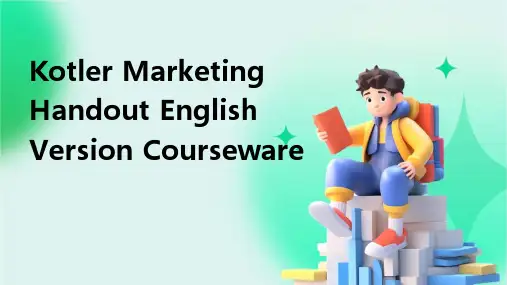
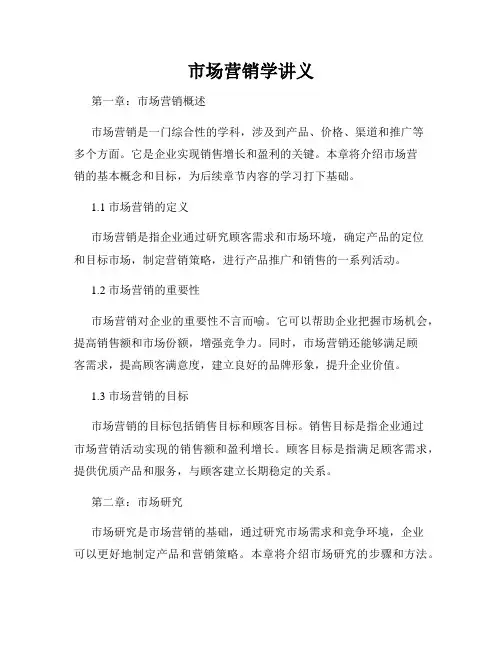
市场营销学讲义第一章:市场营销概述市场营销是一门综合性的学科,涉及到产品、价格、渠道和推广等多个方面。
它是企业实现销售增长和盈利的关键。
本章将介绍市场营销的基本概念和目标,为后续章节内容的学习打下基础。
1.1 市场营销的定义市场营销是指企业通过研究顾客需求和市场环境,确定产品的定位和目标市场,制定营销策略,进行产品推广和销售的一系列活动。
1.2 市场营销的重要性市场营销对企业的重要性不言而喻。
它可以帮助企业把握市场机会,提高销售额和市场份额,增强竞争力。
同时,市场营销还能够满足顾客需求,提高顾客满意度,建立良好的品牌形象,提升企业价值。
1.3 市场营销的目标市场营销的目标包括销售目标和顾客目标。
销售目标是指企业通过市场营销活动实现的销售额和盈利增长。
顾客目标是指满足顾客需求,提供优质产品和服务,与顾客建立长期稳定的关系。
第二章:市场研究市场研究是市场营销的基础,通过研究市场需求和竞争环境,企业可以更好地制定产品和营销策略。
本章将介绍市场研究的步骤和方法。
2.1 市场研究的步骤市场研究的步骤主要包括问题定义、数据收集、数据分析与解释以及研究报告撰写。
在问题定义阶段,需要明确研究的目的、对象和方法。
数据收集阶段可以通过问卷调查、访谈、观察等方式收集数据。
数据分析与解释阶段是对数据进行统计分析和解释,以得出结论并提出建议。
最后,根据研究结果撰写研究报告,向决策者提供参考。
2.2 市场研究的方法市场研究可以采用定性研究和定量研究的方法。
定性研究主要通过访谈、焦点小组等方式获取对顾客行为和意见的深入理解。
定量研究则通过问卷调查、实验等方式进行数据收集和分析,以得出客观的统计结果。
第三章:产品策划与定价产品策划和定价是市场营销中重要的环节。
本章将介绍产品策划的过程和定价的原则。
3.1 产品策划的过程产品策划的过程包括市场需求分析、竞争分析、产品定位和产品组合的确定。
市场需求分析是指通过市场研究了解顾客需求和市场趋势。

市场营销基本知识英文版完整(可以直接使用,可编辑优质资料,欢迎下载)1.Please draw the pyramid of Maslow’s hierarchy of needs and try to illustrate.A person tries to satisfy the most important need first. When that need is satisfied, it will stop being a motivator and the person will then try to satisfy the next most important need.Physiological needs, they consist of need for oxygen, food, water, and a relatively constant temperature.Safety needs, when all physiological needs are satisfied, the need for security can become active. Adult have little awareness of their security needs except in times of emergency or periods of widespread rioting(暴动). Children often display the signs of insecurity and the need to be safe.Social needs, when the needs for safety and for physiological are satisfied, the need for love, affection, and belongingness can emerge. People seek to overcome feelings of loneliness and alienation(疏离). This involves both giving and receiving love, affection and the sense of belonging.Esteem needs, when above three needs are satisfied; the needs for esteem can become dominant. These involve needs for both self-esteem and for the esteem a person gets from others.Self-actualization needs, when all of the foregoing(上面提到的) needs are satisfied, then the need for self-actualization activated. Self-actualization as a person’s need to be and do that the person was “born to do”. These needs make themselves felt in signs of restless, because they don’t know what restlessness(坐立不安)is about.2.What is the PEST analysis?A PEST analysis of the company’s microenvironments factors will be made in this section. PEST analysis involves identifying the political, economical, social and technological influences on an organization.P—political environmentE—economical environmentS—socio cultural environmentT—technological environmente an example to explain three levels of benefits in terms of product analysis.A Parker fountain pen, the product analysis would be:Core Benefit, Writing implement for communicationReal Product, A physical fountain penEnhanced Product, Brand identity, guarantee period, repair and maintenance service4.What’s PLC? (产品生产周期)A product’s lifecycle can be divided into four stages.Introduction stage is a period of slow sales growth as the product being introduce in the market; this is the most expensive stage.Growth stage is a period of rapid market acceptance and increasing profiles. The product is establishing itself in the market and sales are increasing over time. Maturity stage is a period of slowdown in sales growth, because the product has achieved acceptance by most potential buyers.Decline stage is a period when sales fall off and profit drop.周期表表示的是随着时间的增长,销量产生的变化。
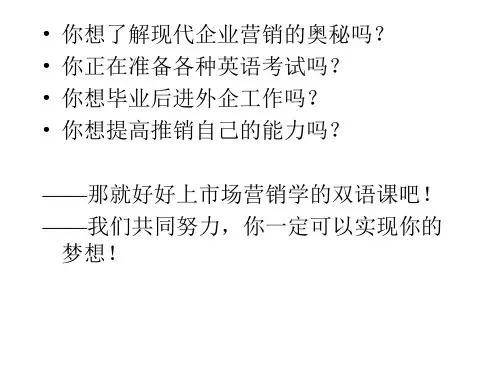
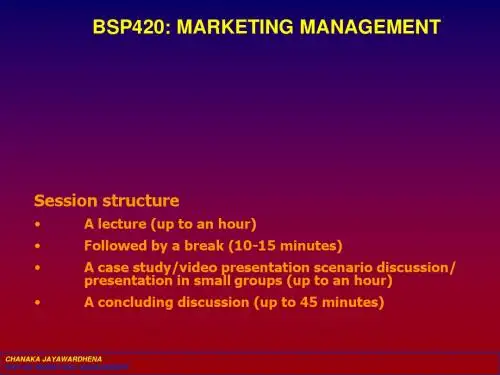
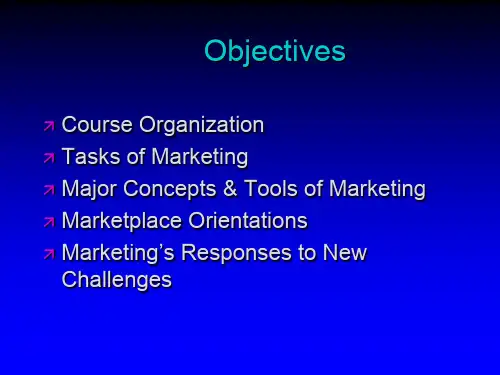
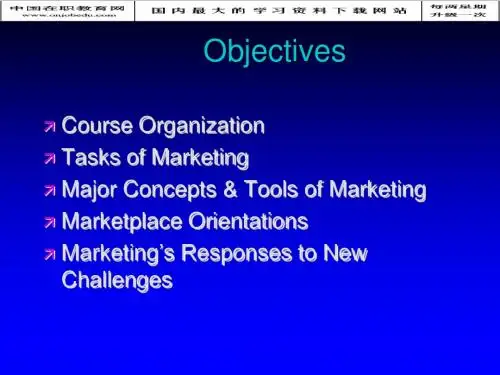
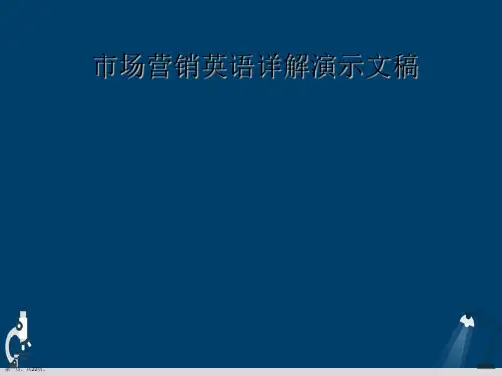
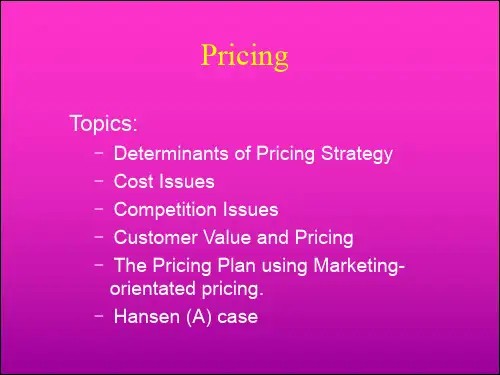
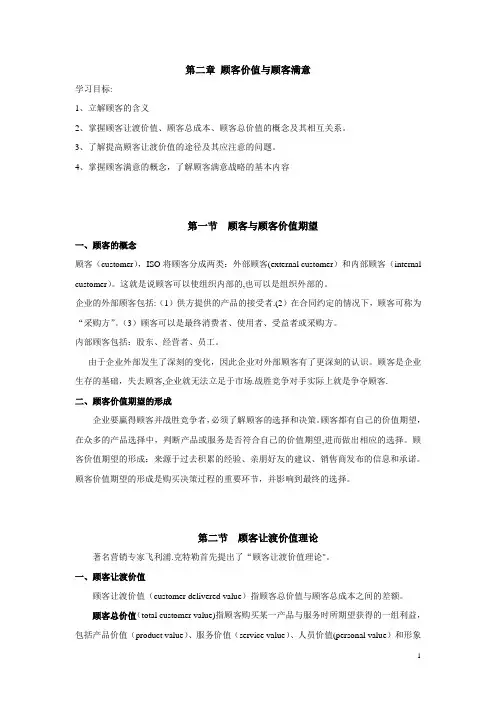
第二章顾客价值与顾客满意学习目标:1、立解顾客的含义2、掌握顾客让渡价值、顾客总成本、顾客总价值的概念及其相互关系。
3、了解提高顾客让渡价值的途径及其应注意的问题。
4、掌握顾客满意的概念,了解顾客满意战略的基本内容第一节顾客与顾客价值期望一、顾客的概念顾客(customer),ISO将顾客分成两类:外部顾客(external customer)和内部顾客(internal customer)。
这就是说顾客可以使组织内部的,也可以是组织外部的。
企业的外部顾客包括:(1)供方提供的产品的接受者.(2)在合同约定的情况下,顾客可称为“采购方”。
(3)顾客可以是最终消费者、使用者、受益者或采购方。
内部顾客包括:股东、经营者、员工。
由于企业外部发生了深刻的变化,因此企业对外部顾客有了更深刻的认识。
顾客是企业生存的基础,失去顾客,企业就无法立足于市场.战胜竞争对手实际上就是争夺顾客.二、顾客价值期望的形成企业要赢得顾客并战胜竞争者,必须了解顾客的选择和决策。
顾客都有自己的价值期望,在众多的产品选择中,判断产品或服务是否符合自己的价值期望,进而做出相应的选择。
顾客价值期望的形成:来源于过去积累的经验、亲朋好友的建议、销售商发布的信息和承诺。
顾客价值期望的形成是购买决策过程的重要环节,并影响到最终的选择。
第二节顾客让渡价值理论著名营销专家飞利浦.克特勒首先提出了“顾客让渡价值理论"。
一、顾客让渡价值顾客让渡价值(customer delivered value)指顾客总价值与顾客总成本之间的差额。
顾客总价值(total customer value)指顾客购买某一产品与服务时所期望获得的一组利益,包括产品价值(product value)、服务价值(service value)、人员价值(personal value)和形象价值(image value)。
顾客总成本(total customer cost)指顾客为购买某一产品所耗费的时间、精神、体力以及所支付的货币资金,包括货币成本(monetary cost)、时间成本(time cost)、精神成本(mental cost)和体力成本(physical cost)。

Unit 1 First Contact1.LISTENING (I)You are going to hear a number of people introducing themselves. Some of the introductions involve two people, some involve three. As you listen, number these conversations in the order you hear them.A Hello, I’m……Nice to meet you, My name’s…….B Hello, let me introduce myself. My name’s…….Pleased to meet you, I’m……..C I don’t know anyone here. You’ll have to introduce me.Of course. Roger, this is…….Nice to meet you.D How do you do? My name’s……Nice to meet you. Mine’s…….E I haven’t met your Managing director yet.Oh, I’m sorry. Doctor Mannheim, this is……Very nice to meet you.F Let me introduce you two. Maxine, this is Francis.Nice to meet you.G Could you introduce me to the Marketing Manager?Of course, Philip, Let me introduce you to …….Nice to meet you2.READ AND LEARN1.LISTENING(II)Manders Plc are having their annual party. Listen to the dialogues overheard at the party. Match up the people’s names with their type of work. The first one has been done for you.2.READ AND LEARN3.PRESENTATIONWe use a variety of prepositions to indicate work relationships.e.g. I work for Manders(they are my employers)I work at Manders (the place)I work with Manders (a sense of collaboration)I’m in computers (general type of work)I’m on the market research side (general type of work)I’m in the Sales Department (specific place of work)4.PRACTICEGroup work1.Introduce yourself to the others.2.Introduce the other two to each other.3.Ask to be introduced.4.Tell your job and place of work.Unit 2 Company Organization-----Presenting the Companyorganizational showing the way a company is organizedstructure organizationManaging Director Director who is in charge of a whole companyexecutives People who put decisions into actionpersonnel stafftraining teaching employees how to do somethingrationalisation making more efficientregion part of a country / an areato split to dividematrix (basis) organized according to two sets of criteria, e.g. geographical andfunctionalsection part of a companysubsidiary company which is owned by a parent companyaffiliate company wholly or partly owned by another company1.LISTENING (I)Listen to the presentation about Rossomon Plc., complete the organization chart below.2.READ AND LEARN3.PRESENTATIONThis section demonstrates some of the language used to describe an organization in terms of:●Hierarchy●Responsibilities/functions●Titles●Affiliates●StructureHierarchyThe company is headed by the MD.The Sales Director reports to the MD.The Sales Director is under the MD.The sales Director is accountable to the MD.The Sales Director is supported by a sales team.The Sales Director is assisted by an Assistant Sales Manager.Responsibilities/functionsThe finance Department is responsible for accounting.The R&D (Research and Development) Department takes care of new product development.The Administration Manager is in charge of personnel.TitlesBelow are the main managerial titles with the US equivalents in brackets:Chairman (President)Managing Director (chief Executive Officer/Senior Vice- President)Finance Director (Vice-President-Finance)Sales Manager (Sales Director)Note: The Directors and Chairman of a company usually sit on the Board of Directors (Executive Board)AffiliatesX is the Parent company.A, B and C are subsidiaries (more than 50% owned by the parent)StructureThe Car Division consists of the Production Department and the Sales Department.The Production Department comprises the Methods Section and the Maintenance Section.The Sales Department is made up of the Advertising Section and the After-sales Section.4.PRACTICEPair work:Describe the typical management structure of a British company.Presenting Information ----Structuring IdeasFocus: A Personnel director giving an informal presentation on the structure and organization of the department.1.LISTENING(II)Listen to the Personnel director of Rossomon plc explaining the structure and organization of the2.READ AND LEARN3.PRESENTATIONA presentation is a talk given by a speaker to one or more listeners. To be effective, the speaker’s message must pass to the listeners, i.e. it must be heard and correctly understood. The elements of an effective presentation are:1.the effective organization of the information2.the effective delivery of the information3.the effective use of language.Below, the skills and techniques needed to organize information effectively are identified. Organization of information--Transparency of structure:have a clear beginning, middle and end.--Organization of content:Identify clearly the main points and the supporting points.In the listening extract, the speaker followed a number of steps:4. PRACTICEPair workFollow the presentation flowchart above, to give a short talk (maximum 5 minutes) to a new member of your company, department or sports/social club. Decide before hand what your and your partner’s roles are.Your presentation should:--- include the relevant information--- have a clear structure--- make that structure clear by using appropriate languageUnit 3 Telephone EtiquetteTelephoning 1 -----Making arrangements1.LISTENING (I)2.READ AND LEARN3.PRESENTATIONThe telephone conversations you heard in the dialogues included a number of steps, in particular: ⏹Identifying yourself/your company⏹Asking the caller to identify himself/herself⏹Asking for a connection⏹Taking/leaving a message⏹Explaining the reason for the call⏹Making appointments⏹Signing offNow look at the language used in these steps.1.Identifying yourself/your companyKrondike Electronics. Can I help you?(a typical switchboard)John Bird speakingThis is Pete EdwardsJohn here2. Asking the caller to identify himself/herselfWho’s calling please?3. Asking for a connectionI’d like to speak to _______________________, please.Could you put me through to _______________, please.I’d like to speak to someone about deliveries, please.4. Taking/leaving a messageI’m afraid he’s out at the moment. Can I take a message?Can you ask him to call me back?5. Explaining the reason for the callThe reason I called is _____________________.I am (just) phoning to ____________________.6. Making appointmentsCould you manage Tuesday?What about Friday?Shall we say two o’clock?Just a moment, I’ll get my diary.I’m sorry, I’m out all day.Friday would be fine.That suits me.7. Signing offI look forward to seeing you.Thanks for calling.Goodbye.Bye.4.PRACTICEPair workStudent A:1)You are a Peterson. Telephone Student B and ask to speak to B Rogers(you can use the titleMr/Mrs/Miss/Ms or their first name). You want to speak to him/her about an order. Your telephone number is (0732) 4355012) B Rogers calls you back. You want to order some shoes. Before you order you would like to know theprice for 10 pairs of model A293. confirm the price and tell him/her you will fax the order right away.3)You are A Taylor. Telephones Student B(B Dunn) to arrange a meeting to discuss your visit to Japan.Telephoning 2 -----Information Handling (Late Payment)Focus: Making phone calls to chase late payments1. LISTENING (II)Listen to a series of three phone calls about late payment of invoices. As you listen, complete the table below.2. READ AND LEARN3. PRESENTATIONIn the phone calls, the parties used the following techniques for handling problems:⏹Asking for repetition⏹Asking for clarification⏹Asking for verification⏹Asking for spelling⏹Correcting informationBelow are some sentences that you can use:1)Asking for repetitionYou may need to ask for repetition in two situations: if you didn’t hear what was said, or if you didn’t understand what was said,A: if you didn’t hear, you can use one of these phrases:Sorry?(with a rising intonation)Pardon? (with a rising intonation)Pardon me? (with a rising intonation)(US)Excuse me? (with a rising intonation)(US)Another strategy is to state your problem and then make a request.Stating your problem:(I’m) sorry. I didn’t hear what you said.I didn’t quite catch what you said.I didn’t quite catch that.Making your request:Could you repeat what you said, please?Could you repeat that /say that again, please?B: If you didn’t understand, you can state your problem and then make a request:Stating your problem:(I’m) sorry. I don’t quite follow you.I don’t understand what you’ve just said.Making your request:Could you go over that again, please?2)Asking for clarificationI you feel the speaker is being vague or imprecise; you can use one of the following expressions to ask for more preciseInformation:What do you mean, exactly?What exactly do you mean by ‘incorrect bank details’?Could you explain what you mean, please?3)Asking for verificationIf you want to check that you have understood what the speaker has said, you can use one of the following expressions:Did you say the Bank of Scotland?(stressed, to check that it is the correct word)Let me just check. The account number is 40211686. Is that right?4)Asking for spellingCan/Could you spell that, please?5)Correcting informationIt is quite common ot soften a correction by using a polite formula before making the correction: (Excuse me.) Not the 30th. The 13th.(Sorry, that’s not quite right.) It should be the 13th, rather than the 30th.(Sorry, I think you’ve made a mistake.)The 13th rather than the 30th.4. PRACTICEPair work4.1 Student A: You are the Marketing Manager of Vitaco, a major supplier of pharmaceutical products. Next month you are spending two days in the Republic of Surnamia to try and boost business there. At present you work through a small agency, surimport. Your agent there has agreed to arrange a number of visits to prospective customers. However, you are not convinced that your agent is really looking after Vitaco’s interests and are keen to show him/her that this visit is important for the future relationship between your two organizations.Call your agent and ask for details of the visits. The visits need to be fitted into and written into the4.2 Student A: You are the agent for Student B’s company (Komestico) in the Republic of Mansuria. Your agency, Mansimport, represents a number of domestic appliance companies. However, you have been able to negotiate better discounts with domestico’s competitors and therefore are better able to sell their products. You have met Domestico’s Marketing Manager(Student B)before and you did not like his/her aggressive manner. Nevertheless, you would like to continue to represent Domestico as they have one good product which you can sell quite easily.Domestico’s Marketing Manager has informed you that he/she intends to visit Mansuria for two days next month and has asked you to set up a number of visits to prospective customers. You don’t really want him/her to come. At the last minute you have contacted a few prospective customers. Below are your notes. Student B is going to call you to ask you for the details.Before Student B calls you, write int the names of the companies and contacts for the visits. Use your imagination to invent some suitable names for the phone conversation.Company:________________________Contact:_______________________Visit: Day 1 10.30 Company:________________________Contact:_______________________Visit: Day 2 12.30 Company:________________________Contact:_______________________Visit: Day 1 14.30Company:________________________Contact:_______________________Visit: Day 2 12.30 Company:________________________Contact:_______________________Visit: Day 1 11.30 Company:________________________Contact:_______________________Visit: Day 2 16.30Unit 4 Sales Review1. LISTENINGListen to the sales review. As you listen, match the model number of the product to the graph. Models: A1456, B2456, C3456Graph 1Sales performance: Model__________________________Sales 000sGraph 2 Sales performance: Model__________________________ Sales 000s Graph 3 Sales performance: Model__________________________Sales 000s2. READ AND LEARN 400 500100 200300 400 5000 1 2 3 4 5 100200 300 400 500 year 6600 600 600Unit5Project ReportingFocus: Two colleagues discussing the progress of a marketing campaign1.LISTENINGListen to the dialogue in which two colleagues discuss the progress of a marketing campaign. As you listen, complete the key for the project planner belowa.b.c.d.e.2.READ AND LEARN3.WORD STUDY4.PRACTICEPair workDiscuss the timing of a project involving the launch of a new product.Student A: Use the project planner below to answer your partner’s questions about project timing. The present date is August 15th.KeyUnit 6 Performance AnalysisFocus: A telephone call between two colleagues discussing quarterly results1. LISTENINGListen to the telephone call between a European Sales Manager and her French area salesman. They are2. READING AND LEARN3. WORD STUDYComplete the expressions by matching the verbs on the left with an appropriate phrase on the right.4. PRACTICEExchange information about Xion’s performance over the last 18 months.Student A: Complete the information chart below by asking your partner questions. Your partner will ask you about the information you have.Unit 7 Arranging a ConferenceFocus: Three colleagues trying to arrange a sales conference1. LISTENING1.1 Information transferListen to the extract from a meeting called to arrange a European Sales Conference. As you listen, complete the secretary ’s notes below.1.2 CommunicationAssess the manner of the three participants in the meeting in terms of assertiveness and submissiveness. √not very √√quite √√√very2. READ AND LEARN3.WORD STUDYFind the word or expression in the box which is closest in meaning to the words in italics in the1.There are three issues we need to discuss…2.… have to settle for September…3.… a trade fair coming up at the end of…4.August is out…5.Hardly time to get over to London…6.Can’t we make it the second weekend…?7.I’ve found the ideal spot…8.Does that include everything?9.… to sort out the details…10.What’s your view, Ron?4.PRACTICEPair workMake an arrangement for a meeting to discuss some new policy questions.Student A: You want to arrange a meeting with Student B. Use the diary to fix a suitable time and placeUnit 8 Competitive AdvantageFocus: A senior Director talking about the competitive position of his company.1.LISTENINGListen to a presentation given by a Director of NETCOUNT Software Ltd, a supplier of accounts software to small business users. He outlines the competitive position of the company. As you listen, complete the2.READ AND LEARN3.WORD STUDYThe following exercise focuses on building vocabulary to describe products, companies and services.4.PRACTICEPair workCompare and contrast two companies.Student A: You should focus on Saffron Inc and make comparisons with Zuchini SA. Student B: You should focus on Zuchini SA and make comparisons with Saffron Inc.Unit 9 Business TransactionsFocus: The Manager of a sportswear shop talking to two new assistants about the transactions and records involved when buying stock.1.LISTENINGListen to the manager of a shop giving two new assistants detailed instructions about the procedures involved when buying stock. As you listen, complete the participant’s note below.2. READ AND LEARN3. WORD STUDYa. Complete the following word table by writing the missing forms in the spaces provided. The first onehas been done for you. Do not include person/agent under Noun. b. Complete the following sentences about order processing with an appropriate word. 1.We usually __________our orders by phone on a Monday.2. We normally__________ delivery of the orders at the end of the week.3. Invoices are normally sent by __________the following week.4. If there is a mistake in the invoice, I normally speak to the supply company by __________.5.After that I usually confirm details of the mistake in __________; and I send the details by __________ so that the suppliers receive the information right away.4. PRACTICE4.1 Pair workStudent A: You have recently joined Outdoor Adventures, a shop selling sports equipment, as their Purchasing Manager. From the shop ’s records, you know that, in the past, Outdoor Adventures bought goods from the supplier, Western Sports. As times are hard in sports equipment retailing, you need to get the best possible payment terms: 15% discount and payment 90 days after delivery.Call them for a quote for the following equipment and complete the quote record form below.4.2 Group workIn small groups, design an order form for Outdoor Adventures using the information given in the listeningsection, together with any additional information that you think might be useful.Unit 10 Sales TrainingFocus: A Sales Manager and his Regional Sales Managers discussing the importance of customer service1.LISTENINGListen to a group of sales managers discussing details of sales programs designed to improve areas of customer service in the company. As you listen, complete the training plan schedule.2.READ AND LEARN3.WORD STUDYa.Prefixes are often used to form negatives, e.g. helpful-unhelpful; pleased-displeased. What are theopposites of the following words?1.fair 3. legal 5. practical 7.possible 9. satisfied2.efficient 4. acceptable 6. employed 8. suitable 10. logicalplete the following sentences with one of the negatives from the previous exercise.1.It is now __________to practice discrimination on the basis of race, color, sex or creed.2.__________workers can have a negative influence on their colleagues.3.We have looked at your proposal, but have found your prices totally__________.4.This interview procedure is very__________: it takes twice as long as it should.5.We regret that it is__________ for us to meet the deadline. Could we agree on extra week?4.PRACTICE4.1 Pair workStudent A: You are a Manager who has just completed a training course with your company. Your boss4.2 Group workIn small groups, discuss a training course that you have recently attended. You can use the above questionnaire for your discussion. Use as many quantifiers as possible.Unit 11 The Supply ChainFocus: A presentation by a Director of Logistics about the supply chain1. LISTENINGListen to a presentation, in which a Director of Logistics describes the supply and distribution chain in his electronics business. As you listen, complete the flow-chart below.2.3.WORD STUDYThree words which are often confused are: to supply, to deliver, to dispatch (also: dispatch). Look at these examples:We supply many of the motor manufactures in the area. =sell goods toWe deliver on a two monthly basis. =send goods to our customersWe just dispatched the last consignment. =sent …from our premises 171.We have been their __________ for many years.2.I don’t believe they are going to stop using us just because one __________ was late.3.The problem occurred because the __________department was on strike.4.Good __________always __________on time, whatever the problems with __________.5.Can you __________these goods to the standard we require? It’s not just a question of__________times.4.PRACTICEGroup workEach member of the group should prepare and make a short presentation describing one of the following processes:--recruiting a new employee--running a marketing campaign--chasing an unpaid invoice--reducing inventory levels--booking a holiday--getting to workUnit 12 Dealing with GrowthFocus: The Director of the Milk Marketing Board giving a presentation about market trendspie chart circular chart divided into segmentssector share market share held by one product sector in the marketweight of publicity great quantity/influence of publicitylow fat diet regime of eating only food with no or low fatinitial firstconsumer resistance consumers’ negative attitude towards a product/serviceconsumer awareness consumers’ knowledge about a product/service1.LISTENINGListen to a presentation, given by the Director of the Milk Marketing Board, about trends in the milk drinks market. As you listen, complete the keys to the figures below.10 years ago: 280m litersNow: liters: sector: sector: sector: sector: sector: sector: sector: sector2.READ AND LEARN3.WORD STUDYGroup the verbs below under the four headings.to expect to slow downto increase to declineto speed up to projectto rise to plummetto rocket to sinkto fall to accelerateto predict to anticipateto go up to calm downUpward trend Downward trend Future estimate Speed of change to increase in decline to expect to slow down4.PRACTICEPair workStudent A: (I) Describe the trends presented in the following graph. (ii) Complete the second graph by listening to your partner’s description. Industrial production trends (1985=100)Unit 13 Company PolicyFocus:An extracts from a presentation given by a Managing Director as he reviews the company ’s achievements over the last ten years1. LISTENINGListen to the Managing Director of Rossomon giving an overview ofthe organization and what it has achieved in the areas noted below. As you listen, complete the notes of the Managing Director ’s talk.2.READ AND LEARN3.WORD STUDYplete the following sentences by writing the words in brackets in the correct form. The first onehas been done for you.1. A SWOT analysis identifies a company’s strengths and weakness .(strong; weak)2.I have been very __________with this year’s results. (satisfaction)3.Every junior manager can expect to be __________to middle management within five years.(promotion)4.If the __________situation does not improve substantially we should be forced to lay off staff.(finance)5.At the moment we are facing stiff __________from other European companies. (competitor)6.We are happy to __________different schemes for our employees. (arrangement)b.Now complete the following word table by writing the missing forms in the spaces provided. The firstone has been done for you.4.PRACTICEGroup workPrepare and give a short presentation (maximum 5 minutes)on one of the following areas:--your company’s pay policy--training in your company--your company’s promotion practice--communications in your company.When you give your presentation, make sure that you use connectors to link your sentences and ideas.Unit 14 Pricing DecisionsFocus: An extract from a meeting in which prices are discussed1.LISTENINGListen to the extract from a meeting in which four colleagues discussing pricing strategy for a new product. As you listen, complete the notes on the writing pad on the left, then use these notes to2.READ AND LEARN3.WORD STUDYComplete the following sentences with appropriate prepositions.1.I’d like you to look __________ these figures. You’ll see…2.The price is made __________of many elements.3.We have set the target price __________$24.4.There figures are based __________the retail price index.5.At the moment we’re working __________ a promotion campaign.6.We distribute the produce __________the retailers __________wholesalers.7.We’re aiming __________$200,000 profits in the first year.8.Do you agree __________Helen?9.The fuel cost increase will push the distribution costs __________.10.The retailers have marked __________the price by 15%.4.PRACTICEPair workStudent A:Student B start talking about Issue 1 and 2 below. Interrupt him/her to seek more information/clarification.Issue 1: EnvironmentIssue 2: Ethics in businessTalk about Issue 3 and 4 below. Student B will interrupt you to seek further information/clarification/ Issue 3: Learning a language:--time--difficulty--progress--children versus adults--your experienceIssue 4: Business culture in your country--attitudes to punctualitywork/familyworking hours--management style/organization--private/public sectorUnit 15 Meeting ObjectivesFocus: An extract from a training session for new recruits about the essential elements of business meetings.1.LISTENINGListen to a group of new employees at a training session discussing how meetings should be organized.2.READ AND LEARN3.WORD STUDYNoun+noun compounds are widely used in technical and business English, as they are economical to use: e.g. personnel management rather than the management of personnelchairperson rather than person who chairs a meetingnote-taker rather than person who takes notesAs you can see, some of the compounds are written as one word, some as two words, and some are hyphenated. As the language is continually changing in this area, there are no fixed rules.a.What are the compounds for the following?1. a manager in charge of sales2.the keyboard of a computer3. a person who does work from home4. a person who pays taxes5. a break to have coffee in the morning6.the development of management7. a paper which gives the news8.the control of quality9.an increase in pay10.the team of management in the company11.the industry which makes cars12.the sheet (of paper) which shows the balance of a companyplete the following sentences with an appropriate phrase from the list above.1.We usually advertise our management vacancies in a national .2.As a , I object strongly to the recent changes in governmentlegislation, since I now have to pay more.3.We produce a every year and this is included inour annual report.4.We usually have our at about 10.30.5.I suggest you clean your . I think you’ll it’llwork then.6.The consists of the Chairman and the Directors.4.PRACTICEGroup workSimulate a meeting in small groups, each consisting of between four and six participants.The purpose of the exercise is to practice the conduct of meetings, following the meeting flowchart in the Presentation section of this unit. The chairperson should rotate so that each person chairs at leastUnit 16 Running a Job InterviewFocus: An extract from a meeting between a Personnel Manager and two of her colleagues about how to run a job interview1.LISTENINGListen to a discussion about how to run a job interview. As you listen, complete the notes on interview activities.2.READ AND LEARN3.WORD STUDYThere are five senses: sight, hearing, smell, taste and touch. Each sense has three activities associated with it:e. g.intentional activity to look at the arrangementsunintentional activity to see the balance sheetbeen done for you.1.Just wait a minute. I can hear footsteps. They sound like Geofff’s.2.Did you get a chance to her CV?3.On my way to your office, by chance I some of the other candidates.4.I have read his reference and I nothing but praise about his management style.5.From what I could see, most of the candidates very well-qualified.6.The gas wasn’t only in the offices; you could it everywhere.7.These are our new high-energy sweets. Would you like to ones?8.Just that noise: there must be something wrong with that machine.9.We have a new video on interview techniques. We are going to it at the end of themeeting.10.If you the paper, you would the difference in quality.4.PRACTICEGroup workYou are going to carry out three activities in small groups of about four participants.Activity oneIn an individual interview, these are only two participants: the interviewer and the interviewee; in a panel interview, there is a group of interviewers.Discuss the advantages and disadvantages of each type.Activity twoYour company has a number of vacancies. Discuss with your senior management team whether you should run an individual interview or a panel interview for the following positions:-- skilled factory workers--factory supervisor--executive secretary for the Managing Director--Regional Sales Manager.Activity three。
国际市场营销学培训讲义(英文版) International Marketing Training HandbookSession 1: Introduction to International Marketing1.1 Definition of International Marketing- Explanation of international marketing and its importance in today's globalized world.- Overview of key concepts, such as globalization, market segmentation, and cultural diversity.1.2 Benefits and Challenges of International Marketing- Discussion on the advantages of expanding into international markets, such as increased sales and new business opportunities. - Identification of common challenges, such as cultural differences, legal and regulatory complexities, and competitive pressures.1.3 International Marketing Strategies- Introduction to different strategies for entering international markets, including exporting, licensing, joint ventures, and direct investment.- Examination of factors influencing strategy selection, such as market potential, risk assessment, and resource allocation. Session 2: Market Research and Analysis2.1 Understanding Global Consumers- Analysis of cultural differences and their impact on consumer behavior.- Identification of global consumer segments and trends to targeteffectively.2.2 Market Research Methods- Overview of primary and secondary research methods for gathering market intelligence.- Explanation of techniques for analyzing market data, such as surveys, focus groups, and data mining.2.3 Assessing Market Potential- Examination of key factors to consider when evaluating market potential, including market size, growth rate, and competition.- Introduction to tools and frameworks for assessing market attractiveness and competitiveness.Session 3: Market Entry Strategies3.1 Exporting and Importing- Discussion on the advantages and disadvantages of exporting and importing.- Explanation of export and import processes, including logistics, documentation, and international trade regulations.3.2 Licensing and Franchising- Overview of licensing and franchising as market entry strategies. - Examination of the benefits, risks, and considerations involved in entering into licensing and franchising agreements.3.3 Joint Ventures and Strategic Alliances- Introduction to joint ventures and strategic alliances as collaborative market entry strategies.- Analysis of the advantages, challenges, and factors for successful partnerships.Session 4: Product and Brand Management4.1 Adaptation vs. Standardization- Examination of product and brand adaptation strategies to suit local market preferences.- Discussion on the benefits and risks of standardizing products and brands across international markets.4.2 Product Development and Innovation- Overview of product development processes for international markets.- Introduction to strategies for fostering innovation and staying competitive in global markets.4.3 Branding and Positioning- Explanation of brand building and positioning strategies for global brands.- Examination of the role of culture, communication, and customer perception in successful international branding.Session 5: Communication and Promotion5.1 Integrated Marketing Communications- Introduction to integrated marketing communications (IMC) and its role in international marketing.- Explanation of different promotional tools and channels, such as advertising, public relations, and digital marketing.5.2 Cultural Sensitivity in Communication- Discussion on the importance of cultural sensitivity and adaptation in international communication.- Analysis of successful cross-cultural marketing campaigns and the lessons learned.5.3 Digital Marketing in International Markets- Overview of digital marketing strategies and tactics for reaching global audiences.- Examination of the challenges and opportunities in leveraging digital platforms for international marketing.Note: This training handbook provides an overview of key topicsin international marketing and can be customized to suit specific training objectives and participant needs.Session 6: Pricing and Distribution6.1 Pricing Strategies in International Markets- Explanation of factors affecting pricing decisions in international markets, such as currency fluctuations, local market conditions, and competition.- Introduction to pricing strategies, such as cost-based pricing, market-based pricing, and value-based pricing.6.2 Distribution Channels and Logistics- Overview of distribution channel options in international markets, including direct sales, distributors, agents, and e-commerce.- Examination of logistics considerations, such as transportation, warehousing, and customs regulations.6.3 Channel Management and Relationship Building- Discussion on the importance of effective channel management and relationship building with international partners.- Introduction to strategies for selecting, managing, and incentivizing channel partners.Session 7: Legal and Ethical Considerations7.1 International Legal Framework- Overview of international trade laws and regulations, such as tariff and non-tariff barriers, intellectual property protection, and contract laws.- Explanation of the role of international organizations, such as the World Trade Organization (WTO), in promoting fair trade practices.7.2 Ethical Issues in International Marketing- Analysis of ethical dilemmas and challenges in international marketing, such as cultural sensitivity, advertising standards, and environmental sustainability.- Discussion on the importance of corporate social responsibility (CSR) in international business practices.7.3 Risk Management and Compliance- Introduction to risk management strategies for mitigating legal and ethical risks in international marketing.- Explanation of compliance standards, such as anti-corruption laws and data privacy regulations, that businesses need to adhere to in global markets.Session 8: Market Expansion and Growth8.1 Emerging Markets and Opportunities- Analysis of emerging markets and their potential for business expansion and growth.- Discussion on strategies for entering and succeeding in emerging markets, such as adaptation to local conditions and collaboration with local partners.8.2 International Business Development- Overview of strategies and considerations for expanding and growing international business operations.- Discussion on factors such as market diversification, innovation, and strategic partnerships.8.3 Sustainable International Marketing- Examination of sustainability and responsible business practices in international marketing.- Introduction to concepts such as green marketing, social entrepreneurship, and inclusive business models.Session 9: Cross-Cultural Communication and Negotiation9.1 The Importance of Cross-Cultural Communication- Explanation of the challenges and opportunities presented by cross-cultural communication in international business.- Analysis of cultural dimensions and their impact on communication styles and business practices.9.2 Cross-Cultural Negotiation- Overview of negotiation strategies and techniques in cross-cultural settings.- Examination of cultural norms and practices that influence negotiation processes and outcomes.9.3 Managing Cultural Differences- Discussion on strategies for managing and leveraging cultural differences in international business.- Introduction to intercultural competence skills, such as empathy, adaptability, and cultural intelligence.Session 10: International Marketing Plan10.1 Developing an International Marketing Plan- Step-by-step guide to developing an international marketing plan. - Explanation of key components, such as market analysis, target market selection, marketing objectives, and implementation strategies.10.2 Evaluating and Monitoring International Marketing Performance- Introduction to metrics and tools for evaluating the performance of international marketing activities.- Discussion on the importance of monitoring and adjusting strategies based on market feedback and changing conditions. 10.3 Case Studies and Best Practices in International Marketing- Analysis of real-world case studies and best practices in international marketing.- Examination of successful international marketing campaigns and their underlying strategies and tactics.Note: This training handbook provides an overview of key topics in international marketing and can be customized to suit specific training objectives and participant needs. The content can be expanded upon by incorporating additional case studies, interactive exercises, and group discussions to enhance participant engagement and learning.。